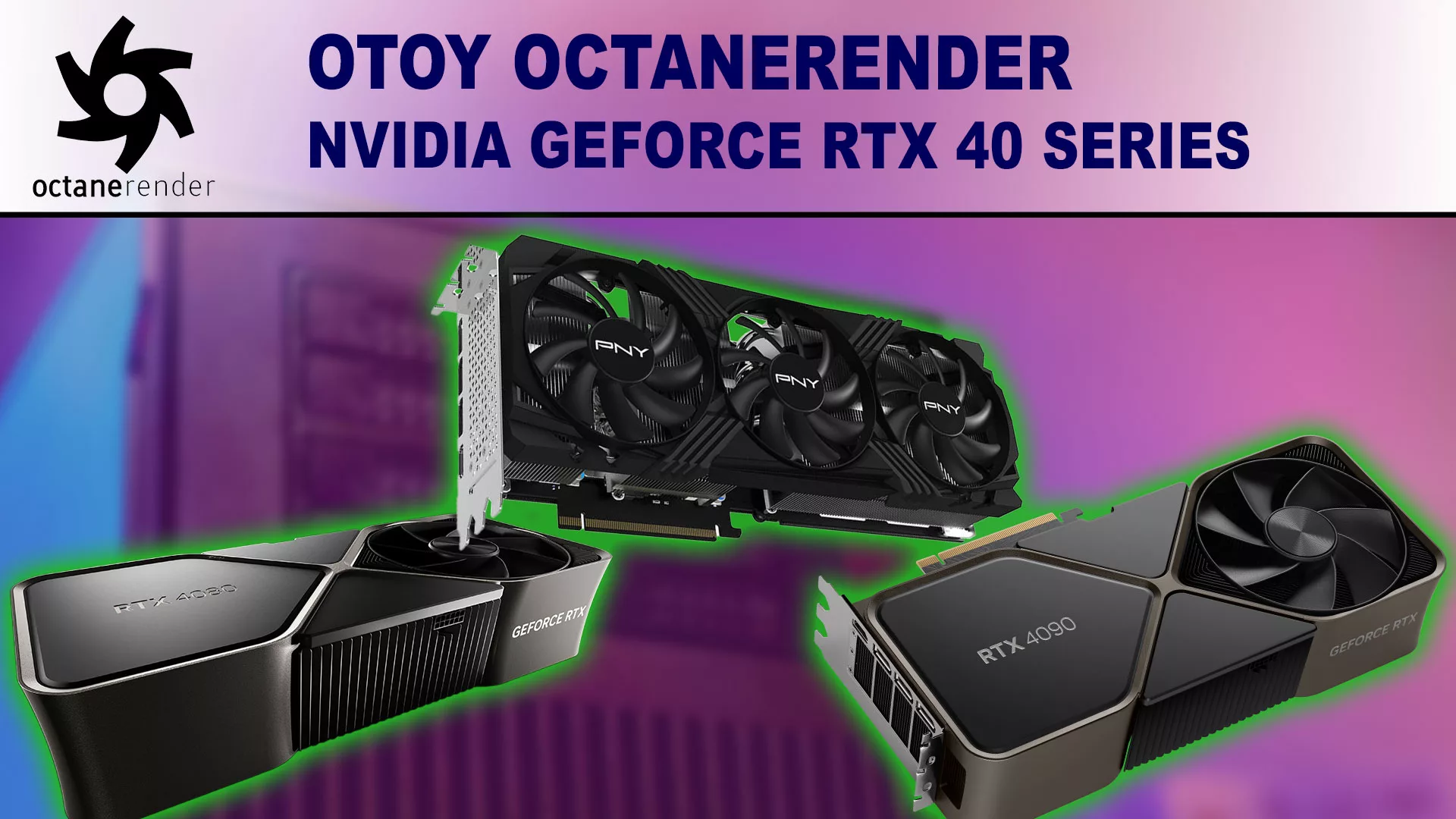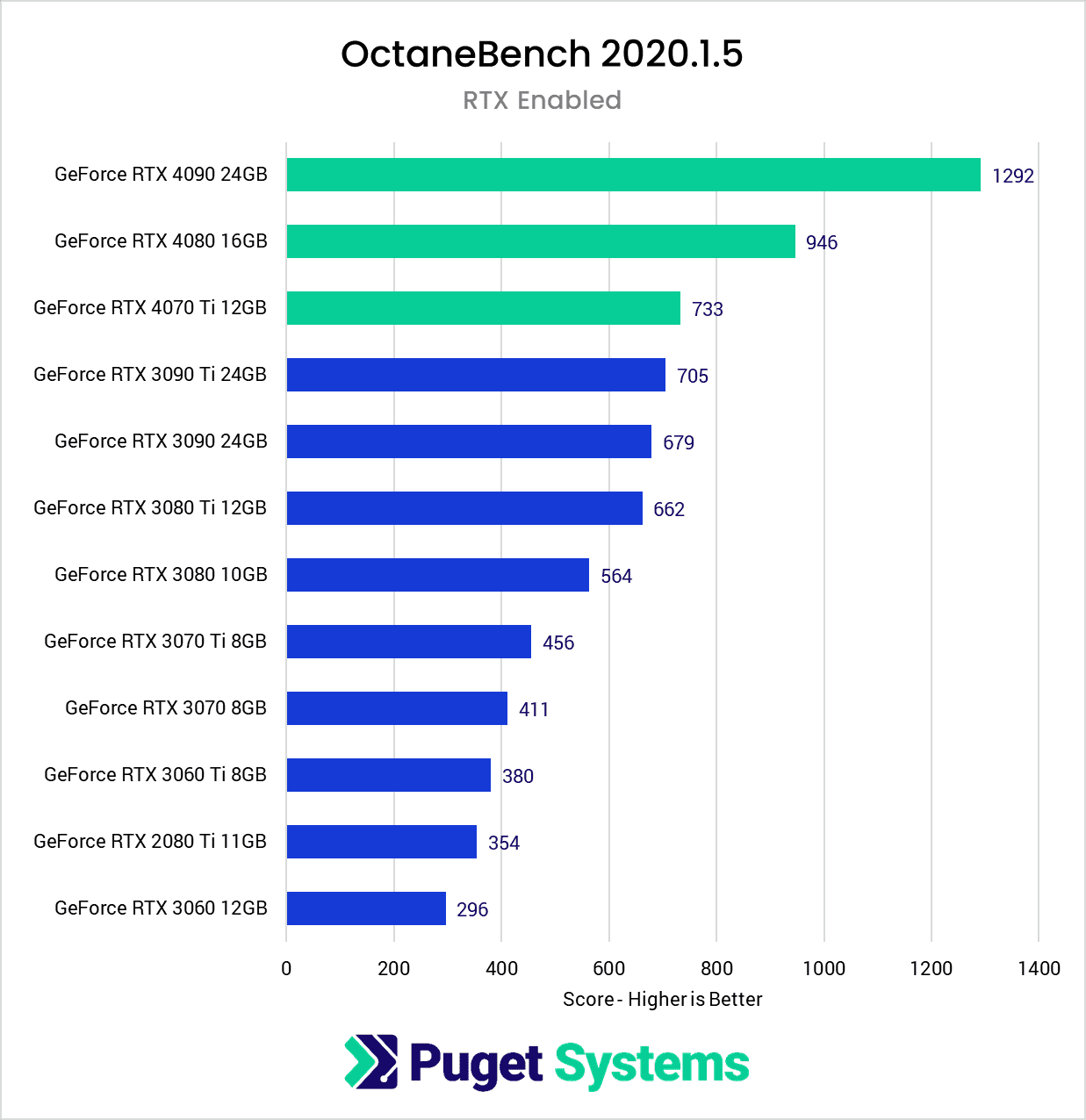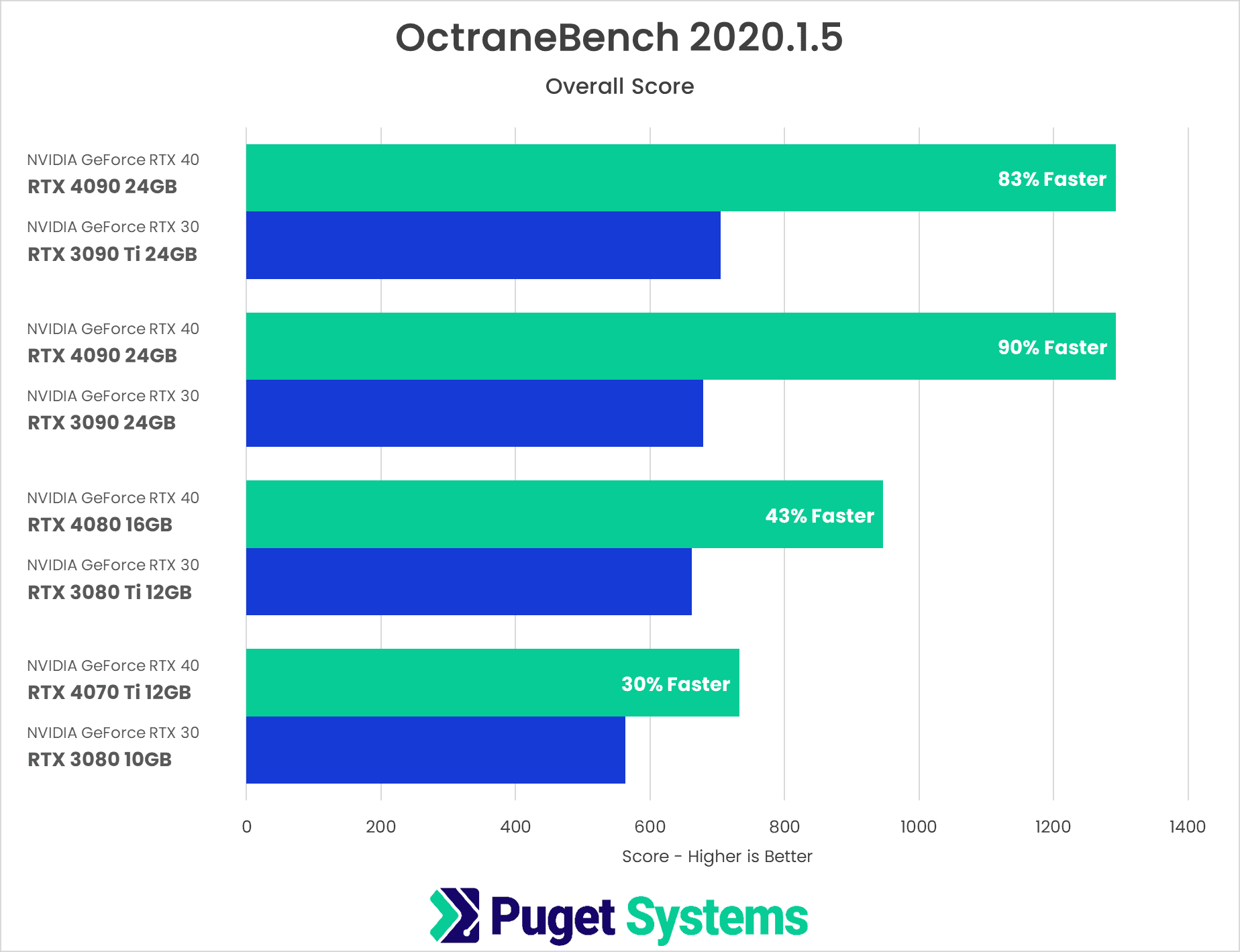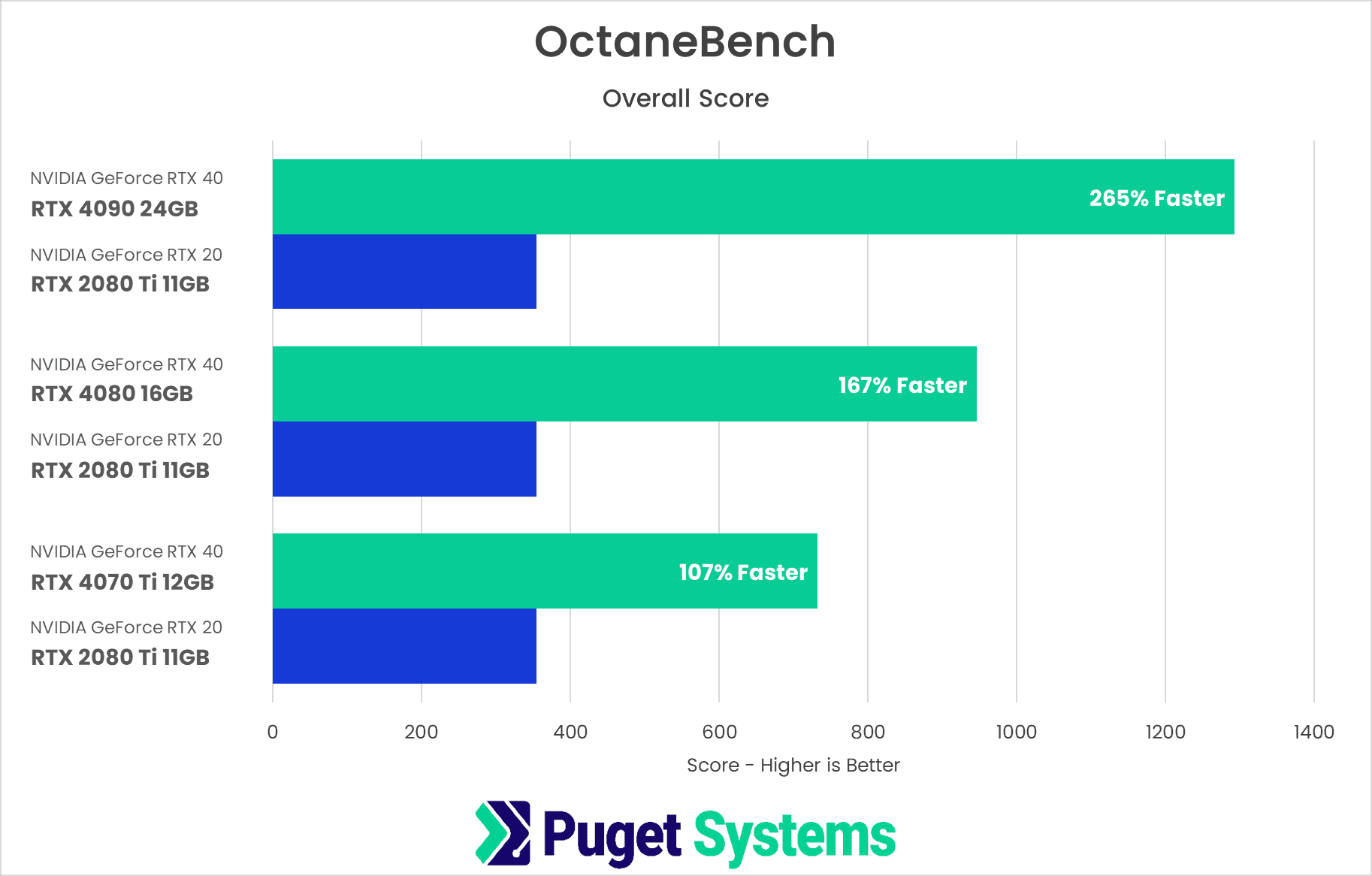Table of Contents
Introduction
NVIDIA has launched the RTX 4070 Ti 12GB, completing the top three GPUs in the new RTX 40 Series. his follows the November debut of the GeForce RTX 4080 16GB and October’s launch of the GeForce RTX 4090 24GB. Now that there is a larger group of these GPUs available, it is an excellent time for us to conduct thorough testing on how these 40 series cards perform in different content creation processes, from 3D rendering to video editing. Specifically, we’ll be looking at Octane Render.

In this article, we will use OctaneBench 2020.1 to examine the GeForce RTX 40 Series performance for GPU rendering. As a comparison, we will include the full lineup from the previous generation GeForce RTX 30 Series, as well as the GeForce RTX 2080 Ti for additional context. Currently, Octane only supports NVIDIA GPUs, so there isn’t a competing product from Intel or AMD for us to compare to.
If you want to read more about the new GeForce RTX 40 Series cards (including the 4070 Ti, 4080, and 4090) and what sets them apart from the previous generation, we recommend checking out our main NVIDIA GeForce 40 Series vs AMD Radeon 7000 for Content Creation article. That post includes more detailed information on the GPU specifications, testing results for various other applications, and the complete test setup details for the hardware and software used in our testing.
Overall Octane Performance Analysis

As we can see, the NVIDIA GeForce RTX 40 Series GPUs dominate the rendering performance in Octane. The newest release, the RTX 4070 Ti 12GB, is faster than every single RTX 30 Series GPU from the previous generation. At a quick glance, all three of these video cards will be great options for GPU rendering. Next, we’ll dig into these results to get a more detailed look at how these stack up.
NVIDIA GeForce RTX 40 Series vs RTX 30 Series

In the above chart, we compare the new generating of cards versus their closest price equivalent in the previous generation. Due to changes in architecture, supply chain, and the like, NVIDIA is not always consistent with its naming scheme, so this gives a better comparison of what performance to expect at a given price point. We added the top-of-the-line RTX 3090 Ti as well, even though it doesn’t have a price equivalent at this point.
Starting with the RTX 4090 24GG, it is 90% faster than the RTX 3090 for only a 7% price increase. It even outpaces the much more expensive RTX 3090 Ti by 83%, a GPU less than a year old. For those looking for the best-performing GPU for rendering, the RTX 4090 24GB is hands down the best option.
Moving on to the RTX 4080 16GB. This GPU costs the same as the RTX 3080 Ti yet delivers 43% faster renders. It also increases the available VRAM from 12GB to 16GB, allowing for larger and more complex renders. Again, this is an excellent gen-over-gen improvement.
Lastly, we look at the latest release, the RTX 4070 Ti 12GB. This GPU is $100 more than the RTX 3080 10GB (roughly 14% more expensive). It returns 30% faster rendering performance for that extra cost and brings an additional 2GB of VRAM. While this is still a welcome upgrade over the RTX 3080, it’s not nearly as impressive as the gains we see with the RTX 4090 and 4080. If we compare by product name, the new RTX 4070 Ti is 61% faster than the RTX 3070 Ti but also 33% more expensive. However we compare it, the RTX 4070 Ti provides more performance than the cost increase but isn’t quite as impressive as its more powerful siblings.
NVIDIA GeForce RTX 40 Series vs GeForce RTX 20 Series

Most users don’t upgrade every generation, so we thought we’d take a moment to compare the new GPUs to the rendering king from only a few years ago. This is less of a price comparison and more just to show how much improvement a user could expect if they think it is time to upgrade. As the chart shows, if someone were to upgrade from a 2080 Ti, they would see improvements from double the speed on the low end to 3.6x faster renders on the top end, depending on which RTX 40 Series card they choose.
How Well Do the NVIDIA GeForce RTX 40 Series Perform in Octane Render?
Overall, the NVIDIA GeForce RTX 40 Series offers great improvements in rendering performance compared to the RTX 30 Series. The RTX 4090 24GB is the standout performer, with a 90% faster rendering performance over the last generation, while the RTX 4080 16GB posted a more modest 43% speed improvement. However, the RTX 4070 Ti 12GB is only 30% faster than the RTX 3080 even though it is 14% more expensive. While this is not nearly as impressive as the RTX 4090 or 4080, it still offers more performance relative to the cost. That increase in performance is even enough to allow the 4070 Ti to outperform the RTX 3090 Ti.
It is worth noting that these tests do not take into account the amount of VRAM available. With GPU rendering, VRAM can become constrained somewhat easily as scenes become larger and more detailed. This can lead to “out of memory” errors or defaulting back to CPU rendering and losing out on GPUs’ speed advantages. Also, note that NVLink is not offered on any of these GPUs, so pooling the VRAM of two GPUs is no longer an option.
Keep in mind that the benchmark results in this article are strictly for Unreal Engine and that performance will vary widely in different applications. If your workflow includes other software packages, we highly recommend checking out our NVIDIA GeForce 40-Series vs AMD Radeon 7000 for Content Creation article, which includes results and links to in-depth testing for a range of other applications, including Premiere Pro, After Effects, DaVinci Resolve, Unreal Engine, and Blender.


